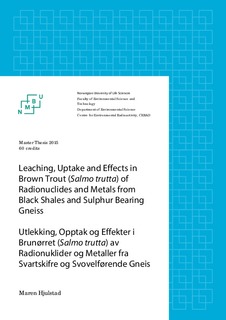| dc.contributor.author | Hjulstad, Maren | |
| dc.date.accessioned | 2015-08-04T08:26:02Z | |
| dc.date.available | 2015-08-04T08:26:02Z | |
| dc.date.copyright | 2015 | |
| dc.date.issued | 2015-08-04 | |
| dc.identifier.uri | http://hdl.handle.net/11250/294400 | |
| dc.description.abstract | Sulphur rich rocks can leach high concentrations of radionuclides and metals into the aquatic environment, when exposed to air and moisture and this might lead to uptake and negative effects in aquatic organisms. Thus during construction in areas with these types of rocks, information about possible leaching and critical levels are needed to perform risk analysis. The present work focuses on the transfer of radionuclides and metals from rock to water and further to organism.
Six rock samples, five black shales and one sulphur bearing gneiss, were collected from different road and rehabilitation projects in Norway. Two leaching experiments were conducted to assess the presence and concentrations of radionuclides and metals in the leachate, as well as the pH and concentrations of major ions. The leachates from the crushed alum shale samples (100g rock/L) increased continually during the experimental period of seven weeks and were dominated by high concentrations of uranium (118-602 µg/L), cadmium (0.06-0.98 µg/L), and molybdenum (77-2032 µg/L) in combination with high pH (7.5-8.0) and high concentrations of major ions (48-515 mg Ca/L). The sulphur bearing gneiss leachate was dominated by high concentrations of aluminium (11601 µg/L), copper (535 µg/L), manganese (513 µg/L) and nickel (261 µg/L), in combination with low pH (2.8-4.2) and low concentrations of major ions (3.8 mg Ca/L).
The exposure experiment showed significant uptake of and uranium (0.7 and 0.1 µg/g) in gills and liver, and cadmium (0.5 µg/g) in the gills of the fish exposed to the shale waters, and higher uptake compared to the corresponding control and reference fish. The fish exposed to the sulphur bearing gneiss leachate of uranium at a factor of 350 lower (0.47 µg U/L) showed higher uptake of uranium in the gills (0.9 µg/g) compared fish exposed to the shale waters. Thus, the results indicate the importance to understand the underlying mechanism in transfer of radionuclides and metals in risk assessment. The fish exposed to the sulphur bearing gneiss also showed very high concentrations of aluminium in the gills (up to 1042 µg/g) and at levels associated with mortality. This was therefore assumed to be the main reason for the observed physiological changes determined by increased blood glucose and mortality (14%). Thus, the gneiss leachate diluted 1:100 caused mortality, while no dilution of shale leachate illustrate the potential of toxicity and variation between rocks. | nb_NO |
| dc.language.iso | eng | nb_NO |
| dc.publisher | Norwegian University of Life Sciences, Ås | |
| dc.rights | Navngivelse 3.0 Norge | * |
| dc.rights.uri | http://creativecommons.org/licenses/by/3.0/no/ | * |
| dc.subject | Leaching | nb_NO |
| dc.subject | Metals | nb_NO |
| dc.subject | Radionuclides | nb_NO |
| dc.subject | Shale | nb_NO |
| dc.subject | Gneiss | nb_NO |
| dc.subject | Uptake | nb_NO |
| dc.subject | Effects | nb_NO |
| dc.subject | Salmo trutta | nb_NO |
| dc.subject | Brown trout | nb_NO |
| dc.subject | Glucose | nb_NO |
| dc.title | Leaching, uptake and effects in brown trout (Salmo trutta) of radionuclides and metals from black shales and sulphur bearing gneiss | nb_NO |
| dc.title.alternative | Utlekking, Opptak og Effekter i Brunørret (Salmo trutta) av Radionuklider og Metaller fra Svartskifre og Svovelførende Gneis | nb_NO |
| dc.type | Master thesis | nb_NO |
| dc.subject.nsi | VDP::Mathematics and natural science: 400::Geosciences: 450 | nb_NO |
| dc.subject.nsi | VDP::Mathematics and natural science: 400::Chemistry: 440::Organic chemistry: 441 | nb_NO |
| dc.subject.nsi | VDP::Mathematics and natural science: 400::Zoology and botany: 480::Ecotoxicology: 489 | nb_NO |
| dc.source.pagenumber | 97 | nb_NO |
| dc.description.localcode | M-MINA | nb_NO |

